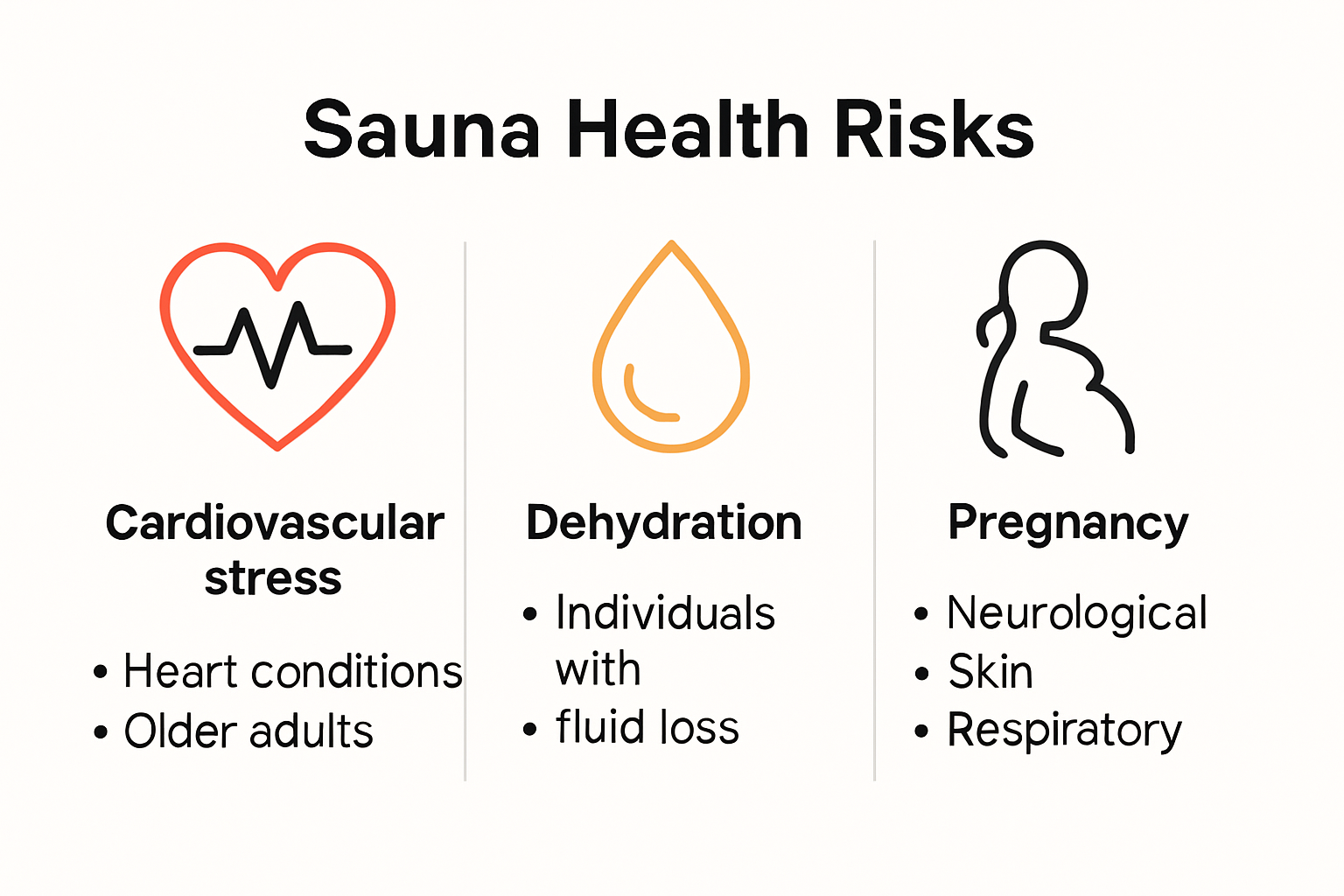
Sauna Health Risks in 2025: What Every Wellness Enthusiast Should Know

Saunas are more popular than ever, with over 30 million Americans expected to use one regularly by 2025 for relaxation and wellness. Sounds like pure self-care bliss, right? Not quite. Some people leave the sauna with more than just a sweat—they face hidden health risks that can turn a relaxing ritual into a serious hazard. Here’s what most wellness guides never mention and why knowing these risks could make or break your next sauna session.
Table of Contents
- Common Sauna Health Risks And Side Effects
- Who Should Avoid Sauna Use
- Safe Sauna Practices For Wellness At Home
- Comparing Sauna Types And Their Risk Levels
Quick Summary
| Takeaway | Explanation |
|---|---|
| Cardiovascular Considerations | Individuals with pre-existing heart conditions should consult a medical professional before sauna use due to potential blood pressure fluctuations and heart stress. |
| Hydration Importance | To prevent dehydration and electrolyte imbalances, drink water before, during, and after sauna sessions, and monitor fluid intake closely. |
| Pregnancy Risks | Pregnant women should avoid sauna use, particularly in the first trimester, due to risks of neural tube defects and potential miscarriage. |
| Post-Sauna Recovery | Post-sauna care, including hydration, cooling down, and maintaining hygiene, is crucial for preventing complications and ensuring a safe experience. |
| Sauna Type Awareness | Different sauna types (traditional, infrared, steam) present unique risks; individuals should assess their health conditions and consult professionals for personalized advice. |

Common Sauna Health Risks and Side Effects
Saunas offer numerous health benefits, but understanding potential risks is crucial for safe and responsible use. While many individuals enjoy sauna sessions without complications, certain health conditions and physiological responses can create unexpected challenges.

Cardiovascular Stress and Potential Risks
Cardiovascular systems undergo significant changes during sauna exposure. According to Harvard Health Publishing, sudden temperature shifts can cause blood vessels to dilate and contract rapidly, potentially stressing heart function. Individuals with pre-existing heart conditions face heightened risks.
Key cardiovascular considerations include:
- Blood Pressure Fluctuations: Intense heat can cause sudden blood pressure changes
- Heart Rate Acceleration: Sauna temperatures can increase heart rate similar to moderate exercise
- Potential Risk for Vulnerable Populations: People with unstable cardiovascular conditions should consult medical professionals before sauna use
Research from the American Heart Association suggests that while short-term risks exist, regular moderate sauna use might actually provide cardiovascular benefits for healthy individuals.
Dehydration and Electrolyte Imbalance Risks
Sauna sessions trigger intense sweating, which can rapidly deplete body fluids and critical minerals. According to Mayo Clinic, excessive sweating without proper hydration can lead to significant health complications.
Potential dehydration consequences include:
- Electrolyte Disruption: Significant loss of sodium, potassium, and other essential minerals
- Muscle Cramps: Mineral depletion can trigger painful muscular contractions
- Heat-Related Illnesses: Severe dehydration might progress to heat exhaustion or heat stroke
Prevention strategies involve drinking water before, during, and after sauna sessions, and monitoring individual hydration levels carefully.
Skin and Respiratory System Considerations
Extreme heat environments can impact skin and respiratory health in complex ways. Dermatology Research indicates that individuals with pre-existing skin conditions might experience unexpected reactions.
Potential skin and respiratory risks include:
- Skin Irritation: Heat can exacerbate conditions like eczema or rosacea
- Respiratory Sensitivity: Some individuals might experience breathing difficulties
- Bacterial Transmission: Shared sauna spaces can potentially spread skin infections if proper hygiene is not maintained
Medical professionals recommend individuals with chronic skin or respiratory conditions consult healthcare providers before regular sauna use. Maintaining personal hygiene and using clean towels can significantly reduce transmission risks.
While these risks exist, they do not negate saunas’ potential health benefits. Informed, responsible use combined with individual health awareness can help mitigate potential complications and ensure a safe, enjoyable experience.
Who Should Avoid Sauna Use
While saunas offer numerous health benefits for many individuals, certain medical conditions and physiological states make sauna use potentially dangerous. Understanding these specific risk factors is crucial for preventing adverse health outcomes.
Cardiovascular Condition Limitations
Cardiovascular health represents the most critical consideration for sauna safety. According to American Heart Association, individuals with specific heart conditions should avoid sauna use entirely.
High-risk cardiovascular conditions include:
- Unstable Angina: Sudden chest pain indicating reduced blood flow
- Recent Heart Attack: Compromised cardiac recovery periods
- Uncontrolled Hypertension: Potential for dangerous blood pressure fluctuations
- Severe Aortic Stenosis: Impaired heart valve function
Mayo Clinic recommends comprehensive medical evaluation before sauna use for individuals with pre-existing heart conditions. These patients should prioritize medical consultation and personalized guidance.
Pregnancy and Developmental Risks
Prenatal health requires exceptional caution regarding temperature exposure. National Institutes of Health warns that excessive heat can potentially harm fetal development.
Pregnancy-related sauna risks include:
- Potential Neural Tube Defects: Elevated body temperatures during early pregnancy
- Risk of Miscarriage: Significant heat exposure in first trimester
- Maternal Cardiovascular Stress: Reduced blood pressure and potential fainting
Expectant mothers should completely avoid sauna use, particularly during the first trimester when embryonic development is most vulnerable.
Neurological and Chronic Health Considerations
Certain neurological and chronic health conditions create additional sauna risks. Epilepsy Foundation highlights specific concerns for individuals with complex medical backgrounds.
Additional high-risk groups include:
- Seizure Disorders: Heat can potentially trigger neurological episodes
- Multiple Sclerosis: Temperature sensitivity might exacerbate symptoms
- Diabetes: Potential complications with temperature regulation
- Individuals Using Medications: Some prescriptions alter heat tolerance
WebMD emphasizes that individuals with impaired thermoregulation face significant risks in high-temperature environments. Professional medical advice becomes paramount for these populations.
The fundamental principle remains consistent: individual health status determines sauna safety. While many people enjoy significant wellness benefits from sauna use, those with specific medical conditions must prioritize professional medical guidance. Comprehensive health assessment and personalized recommendations can help prevent potential complications and ensure individual well-being.
Safe Sauna Practices for Wellness at Home
Creating a safe and beneficial sauna experience requires more than simply stepping into a heated room. Proper preparation, monitoring, and post-sauna care are essential for maximizing health benefits while minimizing potential risks.
Preparation and Hydration Strategies
Preparing for a sauna session begins long before entering the heated environment. Harvard Health Publishing emphasizes the critical importance of hydration and pre-session planning.
Key preparation guidelines include:
- Hydration: Drink at least two to four glasses of water before your sauna session
- Timing: Avoid sauna use immediately after intense physical exercise
- Nutrition: Eat a light meal 1-2 hours before sauna use
- Clothing: Wear minimal, loose-fitting clothing or use appropriate sauna towels
Mayo Clinic recommends starting with shorter sessions and gradually increasing duration as your body adapts to the heat. Beginners should limit initial sessions to 5-10 minutes, progressively extending to 15-20 minutes as comfort and tolerance improve.
Temperature Management and Session Duration
Proper temperature control is crucial for a safe sauna experience. According to American Heart Association, understanding and managing heat exposure prevents potential health risks.
Temperature safety recommendations:
- Optimal Temperature: Maintain between 150-195 degrees Fahrenheit
- Session Length: Limit sessions to 15-20 minutes maximum
- Cooling Periods: Take breaks between sessions to allow body temperature regulation
- Monitoring: Pay attention to personal comfort and physical responses
Individuals should exit the sauna immediately if experiencing dizziness, lightheadedness, or excessive discomfort. WebMD suggests listening to your body and respecting its limitations.
Post-Sauna Recovery and Hygiene
Recovery is as important as the sauna session itself. Proper post-sauna care helps restore body temperature and prevent potential health complications.
Post-sauna best practices include:
- Hydration: Drink water to replenish fluids lost through sweating
- Cooling: Take a lukewarm or cool shower to regulate body temperature
- Rest: Allow your body time to cool down and recover
- Hygiene: Use clean towels and maintain personal cleanliness
National Institutes of Health recommends avoiding alcohol before, during, and immediately after sauna use, as it can interfere with body temperature regulation and increase dehydration risks.
Safe sauna practices are about balance and personal awareness. While saunas offer numerous health benefits, individual responses vary. Consulting with healthcare providers, especially for those with pre-existing health conditions, ensures a safe and enjoyable experience. Remember that wellness is a personal journey, and understanding your body’s unique needs is the first step to effective sauna use.
Below is a summary table to help you quickly review best practices for every stage of a sauna session.
| Stage | Key Actions | Purpose |
|---|---|---|
| Preparation | Hydrate, eat light meal, wear loose clothing | Prevent dehydration, ensure comfort |
| During Session | Limit time (15-20 min), monitor comfort, take breaks | Avoid overheating or fainting |
| Post-Sauna Recovery | Rehydrate, cool shower, rest, maintain good hygiene | Restore balance, aid recovery |
Comparing Sauna Types and Their Risk Levels
Different sauna types present unique health considerations and potential risks. Understanding the specific characteristics of traditional, infrared, and steam saunas helps individuals make informed wellness choices.
Below is a comparison table showing the differences in temperature, humidity, and key risk factors for major sauna types discussed in this article.
| Sauna Type | Temperature (°F) | Humidity (%) | Key Risk Factors |
|---|---|---|---|
| Traditional Finnish | 170-195 | Low | Cardiovascular stress, rapid dehydration |
| Infrared | 110-130 | Low | Electromagnetic sensitivity, skin penetration |
| Steam | ~110-120 | High (100%) | Mold risk, respiratory irritation |
Traditional Finnish Saunas: High Heat Dynamics
Traditional Finnish saunas represent the most intense heat exposure among sauna varieties. Mayo Clinic highlights the significant physiological challenges these high-temperature environments create.
Key risk characteristics include:
- Temperature Range: 170-195 degrees Fahrenheit
- Sudden Blood Pressure Changes: Potential cardiovascular stress
- Rapid Fluid Loss: Accelerated dehydration potential
- Heat Shock Protein Activation: Intense metabolic response
American Heart Association recommends that individuals with cardiovascular conditions exercise extreme caution with traditional saunas. The dramatic temperature fluctuations can strain heart function and potentially trigger adverse reactions.
Infrared Saunas: Lower Temperature Considerations
Infrared saunas operate at lower temperatures while delivering targeted heat directly to body tissues. Harvard Health Publishing suggests these environments offer different physiological interactions compared to traditional saunas.
Unique risk factors include:
- Temperature Range: 110-130 degrees Fahrenheit
- Electromagnetic Field Exposure: Potential sensitivity concerns
- Skin Penetration: Deep tissue heat absorption
- Reduced Sweating Intensity: Less dramatic fluid loss
WebMD indicates that while infrared saunas present fewer immediate risks, individuals with neurological conditions or electromagnetic sensitivity should consult healthcare providers before use.
Steam Saunas: Humidity and Respiratory Considerations
Steam saunas create unique environmental conditions through high humidity levels. National Institutes of Health emphasizes the complex respiratory interactions in these environments.
Potential respiratory and environmental risks include:
- Humidity Levels: 100% relative humidity
- Mold Growth Potential: Increased microbial environment risks
- Respiratory Irritation: Higher likelihood of breathing challenges
- Temperature Perception: Lower perceived heat with high moisture
Healthline recommends individuals with asthma, chronic respiratory conditions, or mold sensitivities approach steam saunas with additional caution.
Each sauna type presents nuanced health interactions. Personal health status, individual physiological responses, and comprehensive medical history determine optimal sauna selection. Consulting healthcare professionals provides personalized guidance for safe and effective sauna use across different technological approaches.
Frequently Asked Questions
What are the health risks associated with sauna use?
Sauna use can lead to cardiovascular stress, dehydration, and skin or respiratory issues, particularly for those with pre-existing health conditions.
Who should avoid using a sauna?
Individuals with unstable cardiovascular conditions, pregnant women, and those with neurological disorders should avoid sauna use or consult a healthcare provider before using one.
How can I safely enjoy a sauna session?
To enjoy a sauna safely, hydrate before and after your session, limit your time to 15-20 minutes, and monitor your body’s responses to heat.
What are the differences between sauna types?
Traditional Finnish saunas have high heat and low humidity, infrared saunas operate at lower temperatures with less sweating, and steam saunas have high humidity, affecting respiratory health differently.
Discover Safer Sauna Wellness for 2025 and Beyond
Have you ever worried that the risks of dehydration, cardiovascular stress, or skin irritation might hold you back from experiencing all the wellness benefits of sauna therapy? The concerns highlighted in the article are real, but the right equipment and careful guidance can make a world of difference. At Best Life Sauna, we believe peace of mind matters just as much as relaxation. Our selection of premium sauna solutions lets you enjoy safe, effective heat therapy at home, featuring temperature controls and accessories thoughtfully designed to help you avoid common pitfalls.

Ready to feel secure and confident in your wellness journey? Visit Best Life Sauna for guidance, exclusive deals, and a curated range of high-quality traditional and infrared saunas. Take control of your at-home wellness and unlock the full benefits of sauna use with a safer, smarter approach. Shop now to benefit from our customer support and limited-time free shipping offer on orders over $200.

